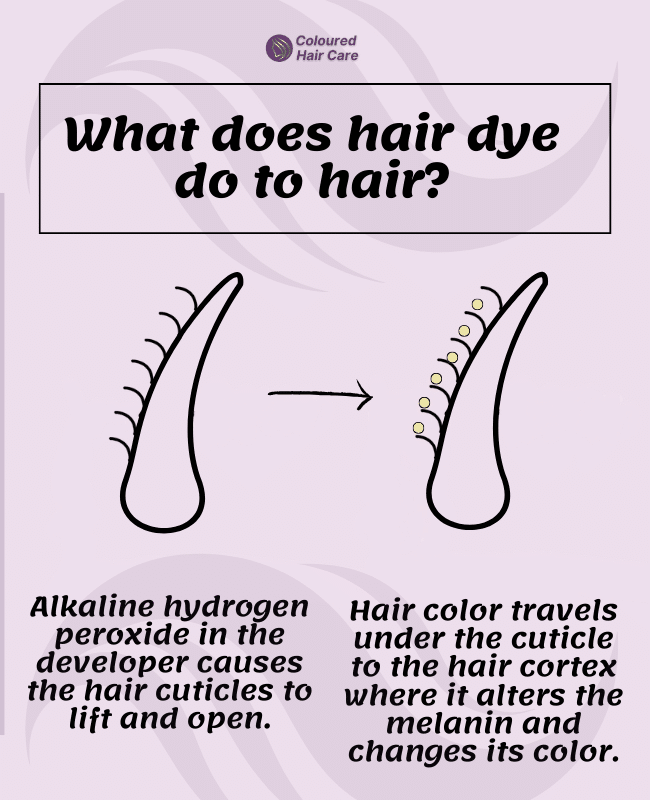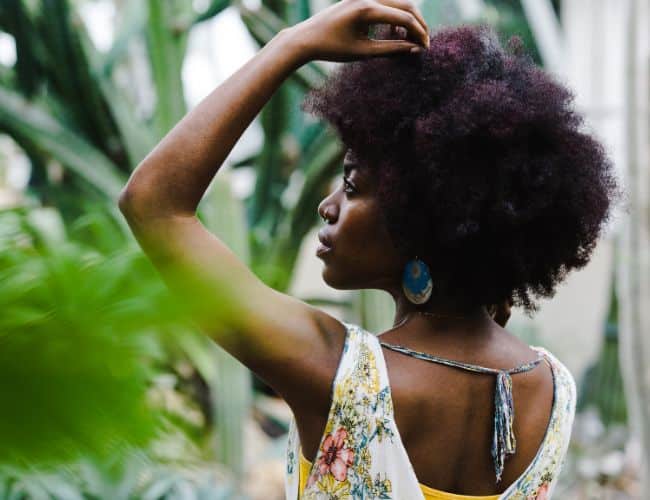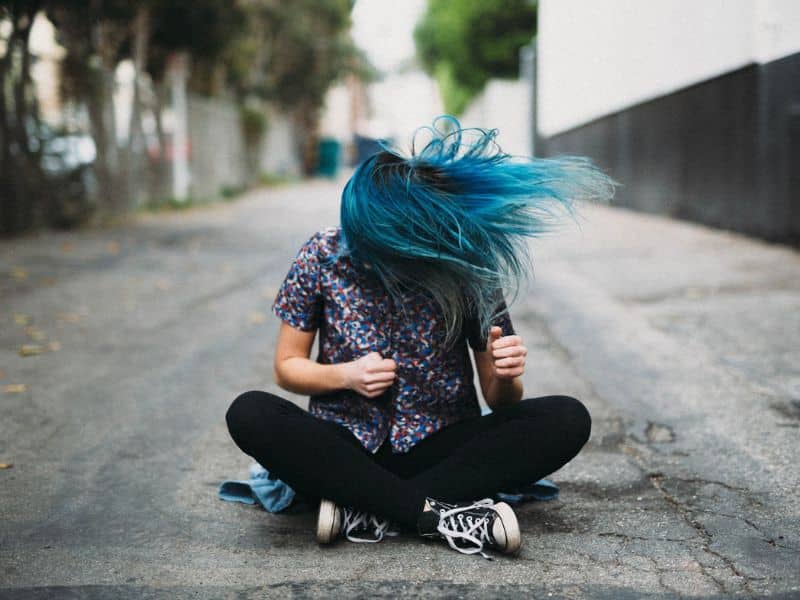Hey there! Wondering if box dye is bad for your hair?
We know that it’s hard to keep up with trends and styles when life gets busy, but here’s a question: Are at-home hair dyes really worth the risk of damaging your hair?
We’re not talking about color changes or shades – we’re saying how it affects the health of your locks.
If you’ve got the time, the technique and the confidence, these handy products are the perfect way to get the hair color you love from the comfort of your own bathroom.
Many trendsetters want to dye their hair at home, but are worried about the chemicals in boxed dyes.
We get it – you love your natural color and don’t want to damage it with harsh chemicals.
But when you do decide to change up your look, or if you’ve got gray hairs that need covering up, they’re a quick and easy way of getting salon-quality results without paying salon prices.
The truth is, box dyes do damage your hair to some degree. But we’re going to tell you why they don’t have to. Read on!
Table of Contents
- Is box dye bad for your hair?
- Watch and learn: The Science Behind Hair Dye
- Does using box dye ruin your hair?
- Box dye before and after
- Exploring the Reasons Why Box Dye Can Be Harmful
- What’s the difference between box dye and professional hair color?
- Is box dye bad for natural hair?
- To Dye or Not to Dye: Making an Informed Decision
- Hair Care Tips: Post-Coloring Best Practices
- Box dye Do’s
- Box dye Don’ts
- Parting words.
Is box dye bad for your hair?
Sady, Yes, box dye is generally bad for your hair.
Box dye can be tough on your hair for several reasons, and it’s sensible to know what they are before deciding to use it to color your strands. Let’s break down why box dye might not always be the best choice for your lovely locks:
- Strong Chemicals: Box dyes often contain harsh chemicals like ammonia, hydrogen peroxide, and resorcinol. These ingredients are necessary to change your hair color, but they can also strip away natural oils, leading to dry, brittle hair.
- One-Size-Fits-All Solution: Box dyes are designed to work on a wide range of hair types and colors, but this ‘one-size-fits-all’ approach might not suit everyone. What works for one person’s hair can be too harsh or ineffective for another’s, leading to unpredictable results.
- Potential for Damage: The process of coloring hair involves breaking down the hair cuticle to deposit color. This can weaken your hair, especially if you’re frequently re-dyeing or going significantly lighter than your natural color.
- Lack of Customization: Professional colorists mix colors and developers based on your hair’s condition, type, and desired result. With box dye, you don’t get this level of customization, which can result in less than ideal color outcomes and increased hair stress(which is also why most hairdressers hate box dye!).
- Allergic Reactions: Some ingredients in box dyes can cause allergic reactions, including itchy scalp, redness, and in severe cases, swelling. It’s always advisable to do a patch test before using any hair dye.
- Over-Processing: If you’re not experienced in dyeing hair, you might leave the dye on for too long, leading to over-processed, damaged hair.
Expert Insights
“Is box color bad? Not really. In fact, many of the formulas in box color are very similar to the formulas used in the salon. What is bad is when you don’t have a professional hair colorist (not a general stylist who didn’t study color) apply the color.”
Karen Marie Shelton, CEO at Hair Boutique
Watch and learn: The Science Behind Hair Dye
Here’s a great video that shows you how hair dye actually works and why it can be harsh on your hair to get the look you love.
Expert Insights
“At a salon, a colorist will use the right mix of color tones and levels to suit the condition of your hair, as well as your natural coloring and skin tone. A box color is one-size-fits-all which won’t look great and will only damage your hair.”
Enza Piazza, Hair Stylist & Color Consultant
Does using box dye ruin your hair?
Although it’s great way to quickly change your look, you may be surprised to find that box dye is not the best option for maintaining healthy hair.
What’s more, many hair dyes do contain harsh chemicals that can strip away essential oils from strands and lead to breakage.
So should we stop using them altogether? Let’s take a look at the pros and cons so you can decide for yourself!
Box dye pros
- It’s affordable.
- It’s convenient.
- It’s easy to do.
Box dye cons
- It’s unpredictable.
- It can go wrong.
- It can be messy.
Box dye before and after
Exploring the Reasons Why Box Dye Can Be Harmful
The chemicals used in shop-bought hair dye are cheap and largely unregulated, which means they are often harsh on your locks.
If you’re box dying your hair, it’s important to know what kind of chemicals are in the dye and how they affect your hair health.
For instance, ammonia opens up the cuticle layer in the hair shaft which allows pigment molecules to deposit on strands more easily. This can lead to dryness, brittleness and breakage.
To avoid these side effects, try using products with less harsh ingredients like sodium hydroxide or ammonium sulfate – you’ll find these is semi-permanent and demi-permanent hair dyes.
These dyes will still deliver intense colors without drying out your locks.
Despite all of this, studies have shown that box dye is safe to use on hair although they can cause side effects or allergic reactions in some people. That’s why it’s always important to do a patch test before attempting to use box dye at home.

Expert Insights
“Boxed colors have come a long way, and you may have even used one or two with nice results. But, box colors usually contain a heavier dye content or types of pigment that can be more damaging to hair, or that can give you less than ideal results should you decide to change up your look.”
Grant Romundt, Founder of Scissorboy.com
What’s the difference between box dye and professional hair color?
Box dye is typically cheaper and more convenient, but it can be difficult to achieve the desired result.
Professional color, on the other hand, is usually more expensive but tends to be more effective.
Here’s a closer look at the key differences between box dye and professional dye.
- Box dye is usually made with lower-quality ingredients, which can make it harder to achieve the desired results.
- Professional color, on the other hand, is made with higher-quality ingredients and provides better coverage. Professional colorists have access to a wider range of colors than those available in box dyes. As a result, they can usually create a more customized look for their clients.
Finally, professional colorists receive training on how to apply color safely and effectively, minimizing the risk of damage to the hair.
So, which option is right for you? If you’re looking for a cheap and convenient way to change your hair color, box dye may be a good option.
However, if you’re looking for better results and are willing to pay a bit more, professional color may be the way to go.
| Feature | Box Dye | Professional Hair Color |
|---|---|---|
| Ingredients | Standard formula, one-size-fits-all | Customizable, mixed per individual need |
| Cost | Generally cheaper | More expensive, includes service cost |
| Application Process | DIY at home | Applied by a trained professional |
| Color Range | Limited shades available | Wide range of shades, can be mixed |
| Durability | Can vary, often shorter lasting | Typically longer lasting |
| Hair Health Impact | Can be more damaging due to harsher chemicals | Generally less damaging, quality products |
| Predictability of Results | Less predictable, depends on starting hair color | More predictable, tailored to your hair |
| Customization | Limited | High degree of customization |
| Aftercare | Standard aftercare products | Professional recommendations for aftercare |

Is box dye bad for natural hair?
When it comes to natural hair, which is often more delicate and prone to dryness and breakage, the use of box dye can be a bit of a double-edged sword. Here’s a friendly rundown on how box dye interacts with natural hair:
- Harsh Chemicals: Box dyes often contain strong chemicals like ammonia, peroxide, and sulfates. These can strip natural hair of its moisture, leading to dryness and brittleness. Natural hair, being typically more prone to dryness, can suffer more from these effects.
- One-Size-Fits-All Formula: Box dyes are designed to work on a wide range of hair types and colors, which means they may not be tailored to the unique needs of natural hair. This lack of specificity can result in uneven color, excessive dryness, or damage.
- Porosity Issues: Natural hair, especially if it’s curly or coily, tends to be more porous. This means it absorbs and loses moisture quickly. The chemicals in box dyes can exacerbate this porosity, leading to increased dryness and potential damage.
- Risk of Damage: The process of coloring, especially if it involves lightening natural hair, can weaken the hair strands. This risk is heightened with box dye, which may be more aggressive than professional coloring products.
However, not all is doom and gloom. If you decide to use box dye on natural hair, here are some tips to minimize potential damage:
- Patch Test: Always do a patch test to check for allergic reactions.
- Moisturize: Deep-condition your hair before and after dyeing to maintain moisture levels.
- Choose Wisely: Opt for dyes that are free from ammonia, peroxide, and sulfates, if possible.
- Follow Instructions: Stick to the recommended time on the box to avoid over-processing.
- Professional Advice: Consider consulting a professional colorist who has experience with natural hair.
Expert Insights
“Personally, I wouldn’t touch box color for millions of dollars. I know what’s in it, what it does/ doesn’t do, and there is no connection of care for the customer there.”
Heather Conner, Cosmetologist
To Dye or Not to Dye: Making an Informed Decision
Of course, box dyes exist for a reason, right?
They give us the freedom to change up our color and cover our greys without spending fortunes at a salon.
So the fact that they damage your hair doesn’t mean you shouldn’t ever use them.
Straighteners, wavers, curlers and other hot tools damage your hair too. But there’s no stopping us working those beachy waves this year.
The secret to using hair dyes at home is to give your colored hair extra love.
Use nourishing treatments to restore it’s strength and shine – before, during and after dyeing your hair.
Hair Care Tips: Post-Coloring Best Practices
Once a week, smother it in a penetrating deep conditioning mask for extra nourishment.
In between colorings, you can also try an at-home keratin treatment. This will help to restore the bonds in your hair and lock the color to make it last for longer.
A color safe shampoo and conditioner that’s kind to hair color should be the only ones you use to help prolong your color.
Take a look at the health of your hair too.
If it is already dull and lifeless and lacking in lustre, dyeing your hair might not be right for you at this moment. Have a chat with your hairdresser about your options.
Box dye Do’s
- Do check the color chart on the side of the hair dye box to match it to the color your hair is now.
- Do a strand test before you dye the rest of your hair if you’re feeling unsure.
- Do buy two boxes of hair color to get all-over, even coverage. Especially if you are planning on covering stubborn greys.
- Do follow the instructions that come with the hair dye carefully. Even if you have dyed your hair before, every dye is different and can have different ways of application and developing time.
- Do visit your salon if you get it wrong!
Box dye Don’ts
- Don’t leave the dye on for longer than it says in the instructions. It can be tempting as you think it will work better or last longer. But this will be the biggest cause of hair damage. Particularly if you’re using permanent dye.
- Don’t dye your hair too often. Try and use a good cover up to hide new root growth and stretch out time in between dyeing it. These won’t last as long as salon color. So think about alternating salon trips and home dyes to keep your color looking fresh.
- Don’t use a dye stronger than you really need. The type of hair dye you choose should depend on what you want to achieve. From all-over grey coverage, a pop of color or a dramatic new look. Don’t pick a dye that’s not fit for purpose.
- Don’t try and lighten your hair. Color cannot lighten color!
Parting words.
The world of hair coloring is a tricky one.
Some people swear by the virtues of using hair dye at home, others say that’s just not for them.
It can be difficult to find information on what products are best for you and your hair type, which is why we’ve compiled this guide to help you through the process.
Now you know how box dye affects your locks and what steps you need to take in order to make sure they’re healthy again after using boxed color (or any other chemical) repeatedly.
Good luck!
Found your perfect shade? We’d love to see it! Tag us on Instagram @colouredhaircare or Facebook and share your hair dye success stories. Looking for more hair care tips? Check out How to Look After Colored Hair: 11 Expert Secrets For Long-Lasting Color.

